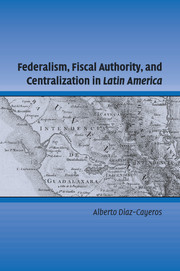Book contents
- Frontmatter
- Contents
- List of Figures
- List of Tables
- Preface
- Federalism, Fiscal Authority, and Centralization in Latin America
- 1 FEDERALISM, PARTY HEGEMONY, AND THE CENTRALIZATION OF FISCAL AUTHORITY
- Part I Fiscal Centralization in Mexico
- 2 REGIONAL FRAGMENTATION AND FAILED COMMITMENT
- 3 THE OFFICIAL PARTY AS A REGIONAL COMPROMISE
- 4 NOMINATIONS, VETO PLAYERS, AND GUBERNATORIAL STABILITY
- 5 TRANSFERS AND REDISTRIBUTION IN THE MEXICAN STATES
- Part II Centralization and Revenue-Sharing in the Latin American Federations
- References
- Index
- Titles in the Series
2 - REGIONAL FRAGMENTATION AND FAILED COMMITMENT
Published online by Cambridge University Press: 08 January 2010
- Frontmatter
- Contents
- List of Figures
- List of Tables
- Preface
- Federalism, Fiscal Authority, and Centralization in Latin America
- 1 FEDERALISM, PARTY HEGEMONY, AND THE CENTRALIZATION OF FISCAL AUTHORITY
- Part I Fiscal Centralization in Mexico
- 2 REGIONAL FRAGMENTATION AND FAILED COMMITMENT
- 3 THE OFFICIAL PARTY AS A REGIONAL COMPROMISE
- 4 NOMINATIONS, VETO PLAYERS, AND GUBERNATORIAL STABILITY
- 5 TRANSFERS AND REDISTRIBUTION IN THE MEXICAN STATES
- Part II Centralization and Revenue-Sharing in the Latin American Federations
- References
- Index
- Titles in the Series
Summary
Taxation, Federalism, and the Dilemma of Regional Development
Taxation lies at the boundary where politics meets economics. In the classical political economy of Adam Smith and David Ricardo, the structure of the tax system (including tariffs restricting trade) determined the development prospects of a country. Fiscal institutions are shaped by the struggle between political organizations and private interests, the former seeking revenue and the latter protecting their assets. In order to collect revenue, rulers must overcome complex issues of measurement, compliance, and monitoring (North, 1981; Levi, 1988). Once tax authorities establish mechanisms to measure the tax base as well as detect and punish tax evasion, such institutions are difficult to change. Adding to the stability of the fiscal system, powerful economic interest groups will lobby to prevent the loss of tax exemptions. Even when not efficient, tax institutions are often stable, changing only when they experience shocks, such as a war, or unexpected windfall revenues (Steinmo, 1993).
Studying the institutional arrangements of tax systems provides a particularly clear view of politics (Schumpeter, 1991[1918]; Steinmo, 1993). Powerful economic and political actors are usually shielded from expropriation or excessive taxation, as reflected in tax institutions, under both democratic and nondemocratic systems. In democracies, representative organizations, court systems, or specific arrangements that divide power – such as the division of federal power into state jurisdictions – provide for effective vetoes to avoid radically redistributive decisions (see North and Weingast, 1989; Acemoglu and Robinson, 2001).
- Type
- Chapter
- Information
- Publisher: Cambridge University PressPrint publication year: 2006



